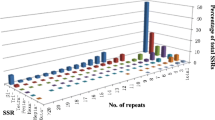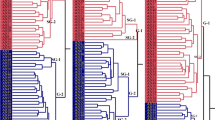Abstract
This study provides a set of useful SSR markers and describes their development, characterization and application for diversity studies.Sixty one Cucumis SSR markers were developed, most of them (46) from melon (Cucumis melo L.) genomic libraries. Forty of the markers (30 melon and 10 cucumber SSRs) were evaluated for length polymorphism in a sample of 13 melon genotypes and 11 cucumber (Cucumis sativus L.) genotypes. PCR-amplification revealed up to six size alleles among the melon genotypes and up to five alleles among the cucumber genotypes, with mean gene-diversity values of 0.52 and 0.28 for melon and cucumber, respectively. These differences are in accordance with the known narrower genetic background of the cucumber. SSR data were applied to phylogenetic analysis among the melon and cucumber genotypes. A clear distinction between the ’exotic’ groups and the sweet cultivated groups was demonstrated in melon. In cucumber, separation between the two sub-species, C.sativus var. sativus and C.sativus var. hardwickii,was obtained. Conservation of SSR loci between melon and cucumber was proven by sequence comparisons.
Similar content being viewed by others
Author information
Authors and Affiliations
Additional information
Received: 17 April 2000 / Accepted: 16 May 2000
Rights and permissions
About this article
Cite this article
Danin-Poleg, Y., Reis, N., Tzuri, G. et al. Development and characterization of microsatellite markers in Cucumis. Theor Appl Genet 102, 61–72 (2001). https://doi.org/10.1007/s001220051618
Issue Date:
DOI: https://doi.org/10.1007/s001220051618




